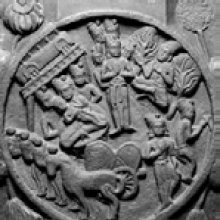Muga, Mūga, Mūgā: 8 definitions
Introduction:
Muga means something in Hinduism, Sanskrit, Buddhism, Pali, Marathi, biology. If you want to know the exact meaning, history, etymology or English translation of this term then check out the descriptions on this page. Add your comment or reference to a book if you want to contribute to this summary article.
Images (photo gallery)
In Hinduism
Shaktism (Shakta philosophy)
Source: Google Books: ManthanabhairavatantramMuga (मुग) refers to “lentils”, according to the Ṭīkā (commentary) on the Manthānabhairavatantra, a vast sprawling work that belongs to a corpus of Tantric texts concerned with the worship of the goddess Kubjikā..—Accordingly, “(Giving this knowledge) to one who has no initiation, no hereafter, lineage, transmission of the teachers, no worship of the Kulakrama and is devoid of the Convention of the Flower and that of the purification of the teachers is like sowing the seeds of wheat, lentils (muga) and the like on barren ground, that is, on stones. It bears no fruit. Or else, it is like the flower (of menses). [...]”.

Shakta (शाक्त, śākta) or Shaktism (śāktism) represents a tradition of Hinduism where the Goddess (Devi) is revered and worshipped. Shakta literature includes a range of scriptures, including various Agamas and Tantras, although its roots may be traced back to the Vedas.
Biology (plants and animals)
Source: Wisdom Library: Local Names of Plants and DrugsMuga in the Assamese language is the name of a plant identified with Litsea monopetala (Roxb.) Pers. from the Lauraceae (Laurel) family having the following synonyms: Litsea polyantha, Tetranthera monopetala, Tetranthera alnoides. For the possible medicinal usage of muga, you can check this page for potential sources and references, although be aware that any some or none of the side-effects may not be mentioned here, wether they be harmful or beneficial to health.
Source: Google Books: CRC World Dictionary (Regional names)Muga in India is the name of a plant defined with Litsea monopetala in various botanical sources. This page contains potential references in Ayurveda, modern medicine, and other folk traditions or local practices It has the synonym Litsea polyantha Jussieu (among others).
Example references for further research on medicinal uses or toxicity (see latin names for full list):
· FBI (1886)
· Plants of the Coast of Coromandel (1798)
· Synopsis Plantarum (Persoon) (1806)
· Plantarum Rariorum Horti Caesarei Schoenbrunnensis (1797)
· Annales du muséum national d’histoire naturelle (1805)
If you are looking for specific details regarding Muga, for example side effects, diet and recipes, extract dosage, pregnancy safety, chemical composition, health benefits, have a look at these references.

This sections includes definitions from the five kingdoms of living things: Animals, Plants, Fungi, Protists and Monera. It will include both the official binomial nomenclature (scientific names usually in Latin) as well as regional spellings and variants.
Languages of India and abroad
Pali-English dictionary
Source: BuddhaSasana: Concise Pali-English Dictionarymūga : (adj.) dumb; a dumb person.
Source: Sutta: The Pali Text Society's Pali-English DictionaryMūga, (adj.) (Vedic mūka; see etym. under mukha) dumb Vin. I, 91 (andha, m. , badhira); Sn. 713; DhA. II, 102 (andha, m. , badhira); SnA 51 (in simile); Sdhp. 12. frequent combined with eḷa, deaf (q. v.). (Page 539)

Pali is the language of the Tipiṭaka, which is the sacred canon of Theravāda Buddhism and contains much of the Buddha’s speech. Closeley related to Sanskrit, both languages are used interchangeably between religions.
Marathi-English dictionary
Source: DDSA: The Molesworth Marathi and English Dictionarymugā (मुगा).—m See mugavā.
--- OR ---
mūga (मूग).—m (mudga S) A grain, Phaseolus mungo. mūga pl khāṇēṃ or giḷaṇēṃ or mugācēṃ karaṇēṃ To bear in silence; to stomach or put up with (abuse, insult): also, sometimes, to keep silence generally.
Source: DDSA: The Aryabhusan school dictionary, Marathi-Englishmūga (मूग).—m A grain, Phaseolus mungo. mūga khāṇēṃ Bear in silence; keep silence.
Marathi is an Indo-European language having over 70 million native speakers people in (predominantly) Maharashtra India. Marathi, like many other Indo-Aryan languages, evolved from early forms of Prakrit, which itself is a subset of Sanskrit, one of the most ancient languages of the world.
Kannada-English dictionary
Source: Alar: Kannada-English corpusMūga (ಮೂಗ):—
1) [noun] a man lacking the power of speech; a dumb man.
2) [noun] a kind of bird.
3) [noun] (fig.) a man who has become temporarily speechless, as from great joy, wonder, fear, etc.
Kannada is a Dravidian language (as opposed to the Indo-European language family) mainly spoken in the southwestern region of India.
See also (Relevant definitions)
Starts with (+243): Muga-bhasma, Muga-dhisko, Muga-moti, Muga-saung-araung, Mugaa, Mugabagaba, Mugabhompala, Mugada, Mugadala, Mugadami, Mugadami-sakhara, Mugadana, Mugadar, Mugadara, Mugadasa, Mugademu, Mugadi, Mugadumi, Mugadumisakhara, Mugagatio.
Ends with (+4): Adavau-muga, Ajemuga, Amuga, Anemuga, Baimuga, Basimuga, Bhayimuga, Bhuimuga, Bhunyimuga, Elamuga, Gilimuga, Ginimuga, Hammuga, Irulmuka, Kamuga, Kamuka, Kimuga, Kolamuga, Magamuga, Muka.
Full-text (+47): Mugadala, Ranamuga, Mugi, Kivuda, Mugavana, Mugyana, Muga-saung-araung, Mukattal, Bodhagem, Mudga, Mugava, Mugabhompala, Koncan-koncamay, Khandira, Pravela, Iru-anaikattai, Munmantapam, Tiru-muga-kkanam, Mugari, Saukhyadayaka.
Relevant text
Search found 3 books and stories containing Muga, Mūga, Mugā, Mūgā; (plurals include: Mugas, Mūgas, Mugās, Mūgās). You can also click to the full overview containing English textual excerpts. Below are direct links for the most relevant articles:
Vinaya Pitaka (3): Khandhaka (by I. B. Horner)
Dwelling not in comfort < [4. Invitation (Pavāraṇā)]
The Jataka tales [English], Volume 1-6 (by Robert Chalmers)
Jataka 538: Mūga-Pakkha Jātaka < [Volume 6]
